Solar eclipse of April 26, 1892
A total solar eclipse occurred at the Moon's ascending node of orbit on Tuesday, April 26, 1892, with a magnitude of 1.0591. A solar eclipse occurs when the Moon passes between Earth and the Sun, thereby totally or partly obscuring the image of the Sun for a viewer on Earth. A total solar eclipse occurs when the Moon's apparent diameter is larger than the Sun's, blocking all direct sunlight, turning day into darkness. Totality occurs in a narrow path across Earth's surface, with the partial solar eclipse visible over a surrounding region thousands of kilometres wide. Occurring only about 13 hours after perigee (on April 26, 1892, at 9:10 UTC), the Moon's apparent diameter was larger.[1]
Description
The eclipse was visible in many parts of the South Pacific Ocean. Very few portions occurred over land including New Zealand except for Auckland and the northernmost portion of North Island, islands such as the Chatham Islands, Antipodes, Marquesas Tahiti and Tuamotu, the westernmost fringes of the Antarctica including its peninsula and the westernmost areas of South America including most of the Andes Mountains in Chile, westernmost Argentina, much of Peru, the southwesternmost of Colombia and Ecuador especially the Galapagos.[2] It was part of solar saros 117.[3]
The umbral portion which was as far as 414 km (257 mi) and started at the peninsular portion of Antarctica, the rest was in the Pacific Ocean. The greatest occurred in the Pacific Ocean at 42.5 S & 119.4 W at 21:55 UTC (1:55 PM local time) and lasted for over 4 minutes.[2]
The eclipse was up to around 20% obscured in many parts of New Zealand and around 10% in Tahiti.
The eclipse started at sunrise in New Zealand and finished at sunset in South America mainly at a part of the Andes Mountains. The eclipse was obscured by clouds in Dunedin.[4][5] It was visible from Timaru further north,[6] but was not visible due to clouds on Banks Peninsula.[7] Wellington also experienced heavy cloud cover and the eclipse was thus not visible.[8]
The subsolar marking was at around the 15th parallel north southeast of Hawaii and northeast of the Palmyra Atoll.
Eclipse details
Shown below are two tables displaying details about this particular solar eclipse. The first table outlines times at which the moon's penumbra or umbra attains the specific parameter, and the second table describes various other parameters pertaining to this eclipse.[9]
| Event | Time (UTC) |
|---|---|
| First Penumbral External Contact | 1892 April 26 at 19:46:52.2 UTC |
| First Umbral External Contact | 1892 April 26 at 21:05:34.5 UTC |
| First Central Line | 1892 April 26 at 21:08:28.4 UTC |
| First Umbral Internal Contact | 1892 April 26 at 21:11:31.1 UTC |
| Equatorial Conjunction | 1892 April 26 at 21:13:25.5 UTC |
| Ecliptic Conjunction | 1892 April 26 at 21:46:27.2 UTC |
| Greatest Eclipse | 1892 April 26 at 21:55:19.9 UTC |
| Greatest Duration | 1892 April 26 at 21:56:19.4 UTC |
| Last Umbral Internal Contact | 1892 April 26 at 22:39:36.1 UTC |
| Last Central Line | 1892 April 26 at 22:42:37.8 UTC |
| Last Umbral External Contact | 1892 April 26 at 22:45:30.8 UTC |
| Last Penumbral External Contact | 1892 April 27 at 00:04:06.0 UTC |
| Parameter | Value |
|---|---|
| Eclipse Magnitude | 1.05908 |
| Eclipse Obscuration | 1.12164 |
| Gamma | −0.88695 |
| Sun Right Ascension | 02h18m58.6s |
| Sun Declination | +13°53'21.2" |
| Sun Semi-Diameter | 15'52.8" |
| Sun Equatorial Horizontal Parallax | 08.7" |
| Moon Right Ascension | 02h20m31.5s |
| Moon Declination | +13°04'03.8" |
| Moon Semi-Diameter | 16'41.6" |
| Moon Equatorial Horizontal Parallax | 1°01'15.8" |
| ΔT | -6.4 s |
Eclipse season
This eclipse is part of an eclipse season, a period, roughly every six months, when eclipses occur. Only two (or occasionally three) eclipse seasons occur each year, and each season lasts about 35 days and repeats just short of six months (173 days) later; thus two full eclipse seasons always occur each year. Either two or three eclipses happen each eclipse season. In the sequence below, each eclipse is separated by a fortnight.
| April 26 Ascending node (new moon) | May 11 Descending node (full moon) |
|---|---|
 | |
| Total solar eclipse Solar Saros 117 | Partial lunar eclipse Lunar Saros 129 |
Related eclipses
Eclipses in 1892
- A total solar eclipse on April 26.
- A partial lunar eclipse on May 11.
- A partial solar eclipse on October 20.
- A total lunar eclipse on November 4.
Metonic
- Preceded by: Solar eclipse of July 9, 1888
- Followed by: Solar eclipse of February 13, 1896
Tzolkinex
- Preceded by: Solar eclipse of March 16, 1885
- Followed by: Solar eclipse of June 8, 1899
Half-Saros
- Preceded by: Lunar eclipse of April 22, 1883
- Followed by: Lunar eclipse of May 3, 1901
Tritos
- Preceded by: Solar eclipse of May 27, 1881
- Followed by: Solar eclipse of March 29, 1903
Solar Saros 117
- Preceded by: Solar eclipse of April 16, 1874
- Followed by: Solar eclipse of May 9, 1910
Inex
- Preceded by: Solar eclipse of May 17, 1863
- Followed by: Solar eclipse of April 8, 1921
Triad
- Preceded by: Solar eclipse of June 26, 1805
- Followed by: Solar eclipse of February 26, 1979
Solar eclipses of 1892–1895
This eclipse is a member of a semester series. An eclipse in a semester series of solar eclipses repeats approximately every 177 days and 4 hours (a semester) at alternating nodes of the Moon's orbit.[10]
The partial solar eclipse on August 20, 1895 occurs in the next lunar year eclipse set.
| Solar eclipse series sets from 1892 to 1895 | ||||||
|---|---|---|---|---|---|---|
| Ascending node | Descending node | |||||
| Saros | Map | Gamma | Saros | Map | Gamma | |
| 117 | April 26, 1892 Total | −0.8870 | 122 | October 20, 1892 Partial | 1.0286 | |
| 127 | April 16, 1893 Total | −0.1764 | 132 | October 9, 1893 Annular | 0.2866 | |
| 137 | April 6, 1894 Hybrid | 0.5740 | 142 | September 29, 1894 Total | −0.4573 | |
| 147 | March 26, 1895 Partial | 1.3565 | 152 | September 18, 1895 Partial | −1.1469 | |
Saros 117
This eclipse is a part of Saros series 117, repeating every 18 years, 11 days, and containing 71 events. The series started with a partial solar eclipse on June 24, 792 AD. It contains annular eclipses from September 18, 936 AD through May 14, 1333; hybrid eclipses from May 25, 1351 through July 8, 1423; and total eclipses from July 18, 1441 through May 19, 1928. The series ends at member 71 as a partial eclipse on August 3, 2054. Its eclipses are tabulated in three columns; every third eclipse in the same column is one exeligmos apart, so they all cast shadows over approximately the same parts of the Earth.
The longest duration of annularity was produced by member 16 at 9 minutes, 26 seconds on December 3, 1062, and the longest duration of totality was produced by member 62 at 4 minutes, 19 seconds on April 26, 1892. All eclipses in this series occur at the Moon’s ascending node of orbit.[11]
| Series members 57–71 occur between 1801 and 2054: | ||
|---|---|---|
| 57 | 58 | 59 |
 March 4, 1802 |  March 14, 1820 | 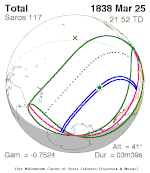 March 25, 1838 |
| 60 | 61 | 62 |
 April 5, 1856 |  April 16, 1874 |  April 26, 1892 |
| 63 | 64 | 65 |
 May 9, 1910 |  May 19, 1928 |  May 30, 1946 |
| 66 | 67 | 68 |
 June 10, 1964 |  June 21, 1982 |  July 1, 2000 |
| 69 | 70 | 71 |
 July 13, 2018 | 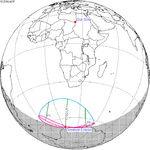 July 23, 2036 |  August 3, 2054 |
Metonic series
The metonic series repeats eclipses every 19 years (6939.69 days), lasting about 5 cycles. Eclipses occur in nearly the same calendar date. In addition, the octon subseries repeats 1/5 of that or every 3.8 years (1387.94 days). All eclipses in this table occur at the Moon's ascending node.
| 22 eclipse events between December 2, 1880 and July 9, 1964 | ||||
|---|---|---|---|---|
| December 2–3 | September 20–21 | July 9–10 | April 26–28 | February 13–14 |
| 111 | 113 | 115 | 117 | 119 |
 December 2, 1880 |  July 9, 1888 |  April 26, 1892 |  February 13, 1896 | |
| 121 | 123 | 125 | 127 | 129 |
 December 3, 1899 |  September 21, 1903 |  July 10, 1907 |  April 28, 1911 |  February 14, 1915 |
| 131 | 133 | 135 | 137 | 139 |
 December 3, 1918 |  September 21, 1922 |  July 9, 1926 |  April 28, 1930 |  February 14, 1934 |
| 141 | 143 | 145 | 147 | 149 |
 December 2, 1937 |  September 21, 1941 |  July 9, 1945 |  April 28, 1949 |  February 14, 1953 |
| 151 | 153 | 155 | ||
 December 2, 1956 |  September 20, 1960 |  July 9, 1964 | ||
Tritos series
This eclipse is a part of a tritos cycle, repeating at alternating nodes every 135 synodic months (≈ 3986.63 days, or 11 years minus 1 month). Their appearance and longitude are irregular due to a lack of synchronization with the anomalistic month (period of perigee), but groupings of 3 tritos cycles (≈ 33 years minus 3 months) come close (≈ 434.044 anomalistic months), so eclipses are similar in these groupings.
| Series members between 1801 and 2200 | ||||
|---|---|---|---|---|
 January 1, 1805 (Saros 109) |  October 31, 1826 (Saros 111) |  August 28, 1848 (Saros 113) | ||
 July 29, 1859 (Saros 114) |  June 28, 1870 (Saros 115) |  May 27, 1881 (Saros 116) |  April 26, 1892 (Saros 117) |  March 29, 1903 (Saros 118) |
 February 25, 1914 (Saros 119) |  January 24, 1925 (Saros 120) |  December 25, 1935 (Saros 121) |  November 23, 1946 (Saros 122) |  October 23, 1957 (Saros 123) |
 September 22, 1968 (Saros 124) |  August 22, 1979 (Saros 125) |  July 22, 1990 (Saros 126) |  June 21, 2001 (Saros 127) |  May 20, 2012 (Saros 128) |
 April 20, 2023 (Saros 129) |  March 20, 2034 (Saros 130) |  February 16, 2045 (Saros 131) |  January 16, 2056 (Saros 132) |  December 17, 2066 (Saros 133) |
 November 15, 2077 (Saros 134) |  October 14, 2088 (Saros 135) |  September 14, 2099 (Saros 136) |  August 15, 2110 (Saros 137) |  July 14, 2121 (Saros 138) |
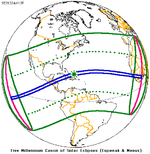 June 13, 2132 (Saros 139) | 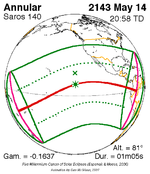 May 14, 2143 (Saros 140) |  April 12, 2154 (Saros 141) |  March 12, 2165 (Saros 142) | 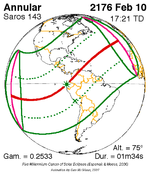 February 10, 2176 (Saros 143) |
 January 9, 2187 (Saros 144) |  December 9, 2197 (Saros 145) | |||
Inex series
This eclipse is a part of the long period inex cycle, repeating at alternating nodes, every 358 synodic months (≈ 10,571.95 days, or 29 years minus 20 days). Their appearance and longitude are irregular due to a lack of synchronization with the anomalistic month (period of perigee). However, groupings of 3 inex cycles (≈ 87 years minus 2 months) comes close (≈ 1,151.02 anomalistic months), so eclipses are similar in these groupings.
| Series members between 1801 and 2200 | ||
|---|---|---|
 June 26, 1805 (Saros 114) |  June 7, 1834 (Saros 115) |  May 17, 1863 (Saros 116) |
 April 26, 1892 (Saros 117) |  April 8, 1921 (Saros 118) |  March 18, 1950 (Saros 119) |
 February 26, 1979 (Saros 120) |  February 7, 2008 (Saros 121) |  January 16, 2037 (Saros 122) |
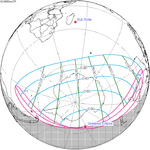 December 27, 2065 (Saros 123) |  December 7, 2094 (Saros 124) |  November 18, 2123 (Saros 125) |
 October 28, 2152 (Saros 126) |  October 8, 2181 (Saros 127) | |
See also
References
- ^ "Moon Distances for London, United Kingdom, England". timeanddate. Retrieved 27 August 2024.
- ^ a b "Solar eclipse of April 26, 1892". NASA. Retrieved March 23, 2017.
- ^ "Solar Saros 117". NASA. Retrieved March 20, 2017.
- ^ "Eclipse of the Sun". The Star. No. 7267. 27 April 1892. p. 3. Retrieved 26 April 2017.
- ^ "The Solar Eclipse". Evening Star. No. 8810. 27 April 1892. p. 2. Retrieved 26 April 2017.
- ^ "Town & Country". The Timaru Herald. Vol. LIV, no. 5401. 28 April 1892. p. 2. Retrieved 26 April 2017.
- ^ "Local and General". Ellesmere Guardian. Vol. XI, no. 1006. 30 April 1892. p. 2. Retrieved 26 April 2017.
- ^ "Notes". New Zealand Times. Vol. LIII, no. 9588. 27 April 1892. p. 2. Retrieved 26 April 2017.
- ^ "Total Solar Eclipse of 1892 Apr 26". EclipseWise.com. Retrieved 27 August 2024.
- ^ van Gent, R.H. "Solar- and Lunar-Eclipse Predictions from Antiquity to the Present". A Catalogue of Eclipse Cycles. Utrecht University. Retrieved 6 October 2018.
- ^ "NASA - Catalog of Solar Eclipses of Saros 117". eclipse.gsfc.nasa.gov.
External links
- Google interactive maps
- Solar eclipse data
- v
- t
- e
| By era | |
|---|---|
| Saros series (list) | |
| Visibility | |
| Historical |
|

Total/hybrid eclipses
→ next total/hybrid
- 1133
- 1185
- 1560
- 1598
- 1652
- 1654
- 1673
- 1706
- 1715
- 1724
- 1766
- 1778
- 1780
- 1806
- 1816
- 1824
- 1842
- 1851
- 1853
- 1857
- 1858
- 1860
- 1865
- 1867
- 1868
- 1869
- 1870
- 1871
- 1874
- 1875
- 1878
- 1882
- 1883
- 1885
- 1886
- 1887
- Jan. 1889
- Dec. 1889
- 1893
- 1896
- 1898
- 1900
- 1901
- 1903
- 1904
- 1905
- 1907
- Jan. 1908
- Dec. 1908
- 1909
- 1910
- 1911
- Apr. 1912
- Oct. 1912
- 1914
- 1916
- 1918
- 1919
- 1921
- 1922
- 1923
- 1925
- 1926
- 1927
- 1928
- 1929
- Apr. 1930
- Oct. 1930
- 1932
- 1934
- 1936
- 1937
- 1938
- 1939
- 1940
- 1941
- 1943
- Jan. 1944
- 1945
- 1947
- 1948
- 1950
- 1952
- 1954
- 1955
- 1956
- 1957
- 1958
- 1959
- 1961
- 1962
- 1963
- 1965
- 1966
- 1967
- 1968
- 1970
- 1972
- 1973
- 1974
- 1976
- 1977
- 1979
- 1980
- 1981
- 1983
- 1984
- 1985
- 1986
- 1987
- 1988
- 1990
- 1991
- 1992
- 1994
- 1995
- 1997
- 1998
- 1999
- 2001
- 2002
- 2003
- 2005
- 2006
- 2008
- 2009
- 2010
- 2012
- 2013
- 2015
- 2016
- 2017
- 2019
- 2020
- 2021
- 2023
- 2024
- → 2026
- 2027
- 2028
- 2030
- 2031
- 2033
- 2034
- 2035
- 2037
- 2038
- 2039
- 2041
- 2042
- 2043
- 2044
- 2045
- 2046
- 2048
- 2049
- 2050
- 2052
- 2053
- 2055
- Jan. 2057
- Dec. 2057
- 2059
- 2060
- 2061
- 2063
- 2064
- 2066
- 2067
- 2068
- 2070
- 2071
- 2072
- 2073
- 2075
- 2076
- 2077
- 2078
- 2079
- 2081
- 2082
- 2084
- 2086
- 2088
- 2089
- 2090
- 2091
- 2093
- 2094
- 2095
- 2096
- 2097
- 2099
- 2100
- 2186

Annular eclipses
→ next annular
- 1820
- 1854
- 1879
- 1889
- 1900
- 1901
- 1903
- 1904
- 1905
- 1907
- 1908
- 1911
- 1914
- Feb. 1915
- Aug. 1915
- 1916
- 1917
- 1918
- 1919
- 1921
- 1922
- 1923
- 1925
- 1926
- 1927
- 1929
- 1932
- Feb. 1933
- Aug. 1933
- 1934
- 1935
- 1936
- 1937
- 1939
- 1940
- 1941
- 1943
- Jul. 1944
- 1945
- 1947
- 1948
- 1950
- Mar. 1951
- Sep. 1951
- 1952
- Jan. 1954
- Dec. 1954
- 1955
- 1957
- 1958
- 1959
- 1961
- 1962
- 1963
- 1965
- 1966
- Mar. 1969
- Sep. 1969
- 1970
- 1972
- Jan. 1973
- Dec. 1973
- 1976
- 1977
- 1979
- 1980
- 1981
- 1983
- 1984
- 1987
- 1988
- 1990
- 1991
- 1992
- 1994
- 1995
- 1998
- 1999
- 2001
- 2002
- 2003
- 2005
- 2006
- 2008
- 2009
- 2010
- 2012
- 2013
- 2014
- 2016
- 2017
- 2019
- 2020
- 2021
- 2023
- → 2024
- 2026
- 2027
- 2028
- 2030
- 2031
- 2032
- 2034
- 2035
- 2036
- Jan. 2038
- Jul. 2038
- 2039
- 2041
- 2042
- 2043
- 2044
- 2045
- 2046
- 2048
- 2049
- 2052
- 2053
- Jan. 2056
- Jul. 2056
- 2057
- 2059
- 2060
- 2061
- 2063
- 2064
- 2066
- 2067
- 2070
- 2071
- Jan. 2074
- Jul. 2074
- 2075
- 2077
- 2078
- 2079
- 2081
- 2082
- 2084
- Jun. 2085
- Dec. 2085
- 2088
- 2089
- Feb. 2092
- Aug. 2092
- 2093
- 2095
- 2096
- 2097
- 2099
- 2100

Partial eclipses
→ next partial
- Jan. 1639
- Apr. 1902
- May 1902
- Oct. 1902
- Feb. 1906
- Jul. 1906
- Aug. 1906
- Dec. 1909
- Nov. 1910
- Apr. 1913
- Aug. 1913
- Sep. 1913
- Dec. 1916
- Jan. 1917
- Jun. 1917
- Jul. 1917
- May 1920
- Nov. 1920
- Mar. 1924
- Jul. 1924
- Aug. 1924
- Dec. 1927
- Jun. 1928
- Nov. 1928
- Apr. 1931
- Sep. 1931
- Oct. 1931
- Jan. 1935
- Feb. 1935
- Jun. 1935
- Jul. 1935
- Nov. 1938
- Mar. 1942
- Aug. 1942
- Sep. 1942
- Jan. 1946
- May 1946
- Jun. 1946
- Nov. 1946
- Apr. 1949
- Oct. 1949
- Feb. 1953
- Jul. 1953
- Aug. 1953
- Dec. 1956
- Mar. 1960
- Sep. 1960
- Jan. 1964
- Jun. 1964
- Jul. 1964
- Dec. 1964
- May 1967
- Mar. 1968
- Feb. 1971
- Jul. 1971
- Aug. 1971
- Dec. 1974
- May 1975
- Nov. 1975
- Apr. 1978
- Oct. 1978
- Jan. 1982
- Jun. 1982
- Jul. 1982
- Dec. 1982
- May 1985
- Apr. 1986
- Mar. 1989
- Aug. 1989
- Dec. 1992
- May 1993
- Nov. 1993
- Apr. 1996
- Oct. 1996
- Sep. 1997
- Feb. 2000
- 1 Jul. 2000
- 31 Jul. 2000
- Dec. 2000
- Apr. 2004
- Oct. 2004
- Mar. 2007
- Sep. 2007
- Jan. 2011
- Jun. 2011
- Jul. 2011
- Nov. 2011
- Oct. 2014
- Sep. 2015
- Feb. 2018
- Jul. 2018
- Aug. 2018
- Jan. 2019
- Apr. 2022
- Oct. 2022
- → Mar. 2025
- Sep. 2025
- Jan. 2029
- Jun. 2029
- Jul. 2029
- Dec. 2029
- 2032
- 2033
- Feb. 2036
- Jul. 2036
- Aug. 2036
- 2037
- May 2040
- Nov. 2040
- Jan. 2047
- Jun. 2047
- Jul. 2047
- Dec. 2047
- 2050
- Apr. 2051
- Oct. 2051
- Mar. 2054
- Aug. 2054
- Sep. 2054
- 2055
- May 2058
- Jun. 2058
- Nov. 2058
- Mar. 2062
- Sep. 2062
- Feb. 2065
- Jul. 2065
- Aug. 2065
- Dec. 2065
- 2068
- Apr. 2069
- May 2069
- Oct. 2069
- 2072
- 2073
- Jun. 2076
- Jul. 2076
- Nov. 2076
- Feb. 2083
- Jul. 2083
- Aug. 2083
- 2084
- 2086
- May 2087
- Jun. 2087
- Oct. 2087
- 2090
- 2091
- Jun. 2094
- Jul. 2094
- Dec. 2094
- Apr. 2098
- Sep. 2098
- Oct. 2098
 Astronomy portal
Astronomy portal Solar System portal
Solar System portal Category
Category















